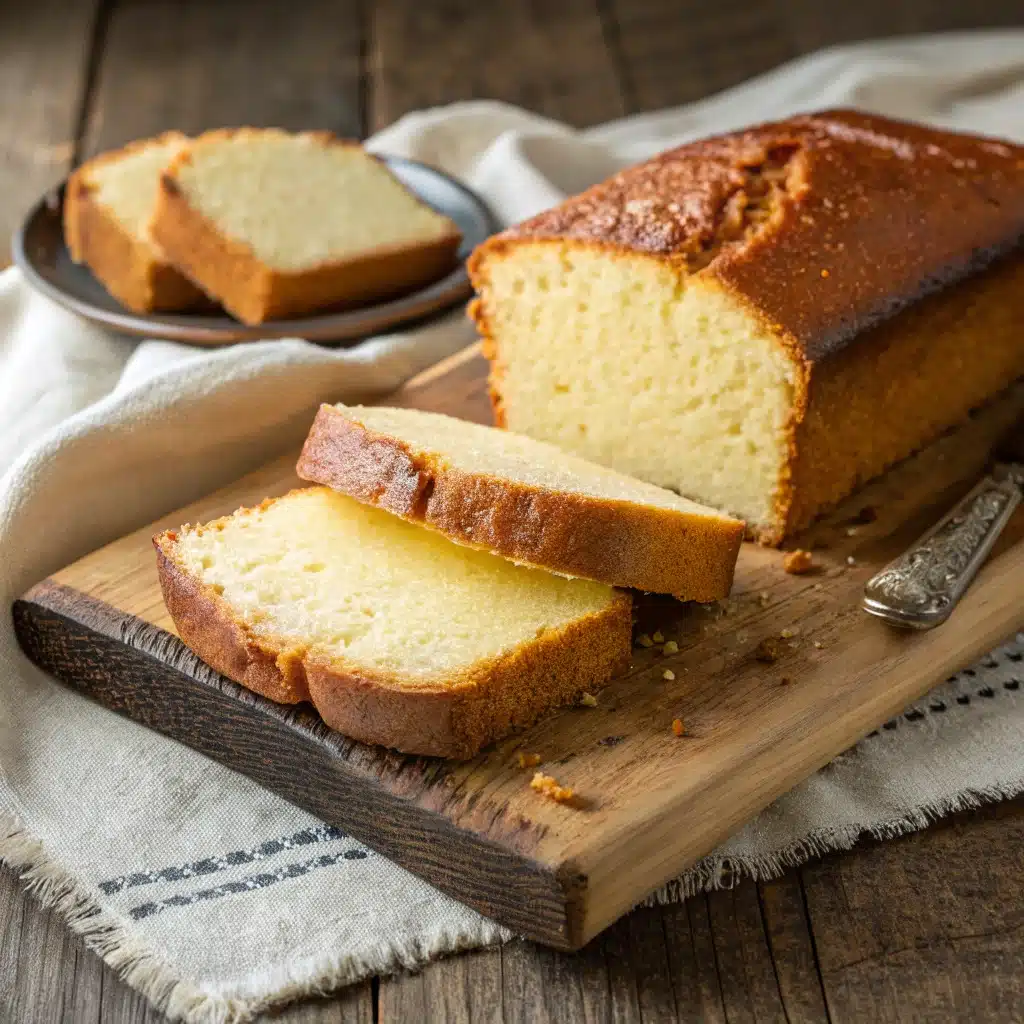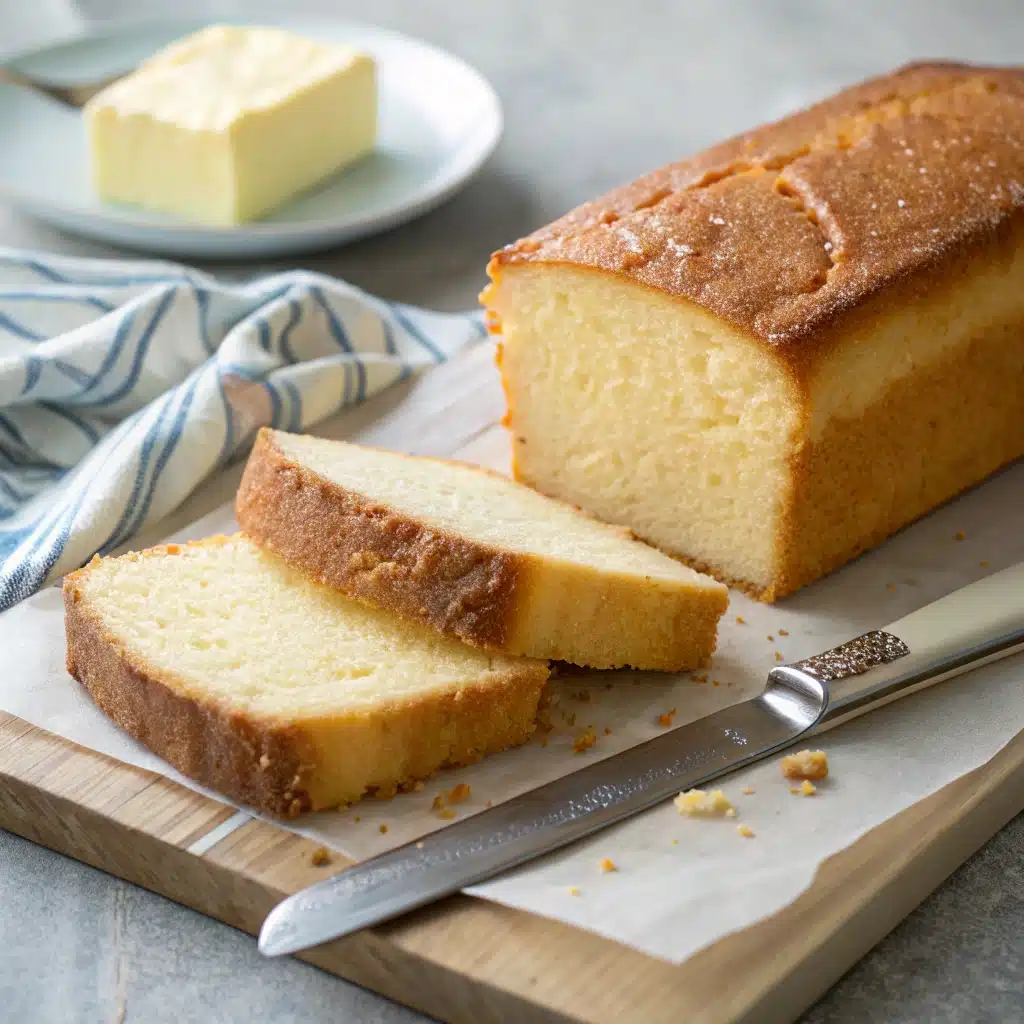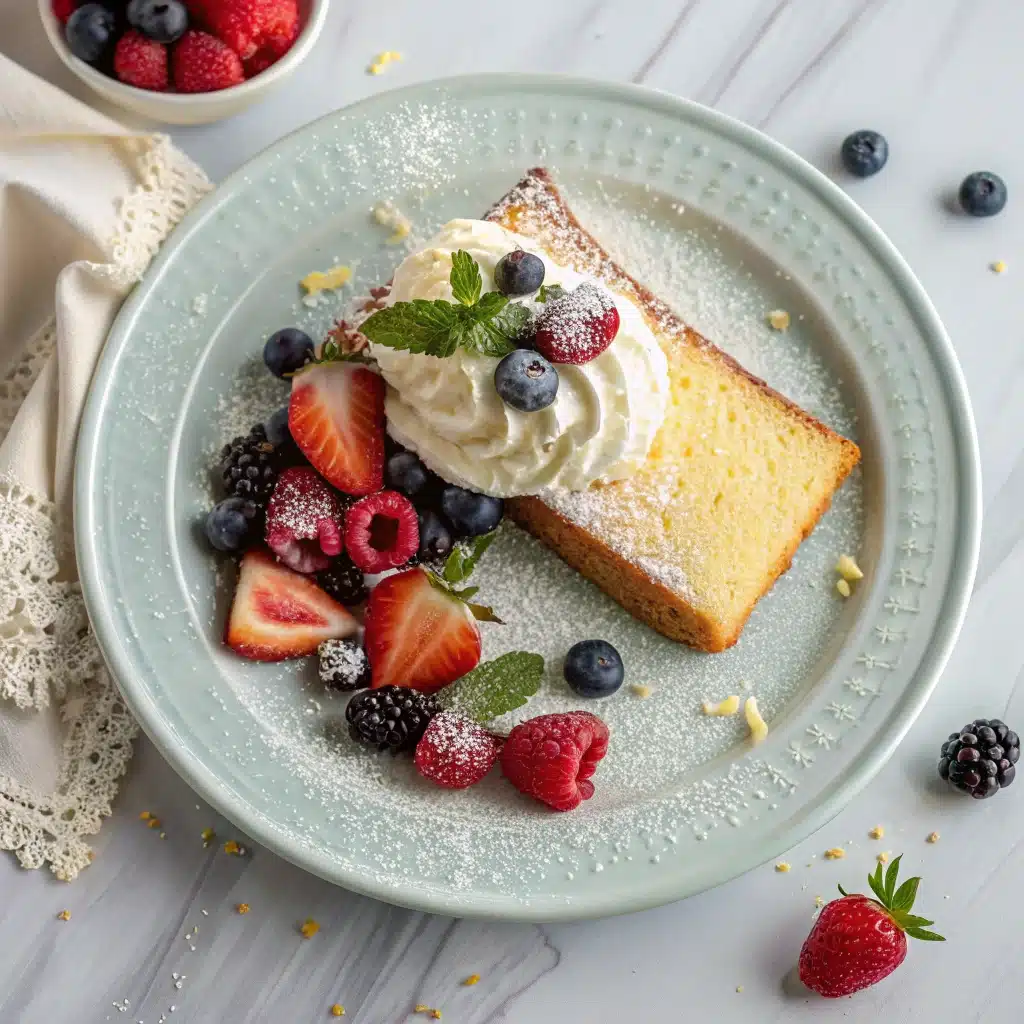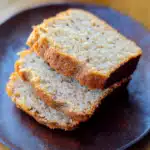Buttermilk Pound Cake isn’t just a dessert. It’s a memory, a tradition, and—if you ask me—a love letter to old-fashioned baking. I’m Mary, affectionately known as “The Pudding Lady” in my town of Bath. My journey with puddings (and all sweet things) began in my mother’s pantry, a haven where golden syrup dripped endlessly, and flour was stored in tall, timeworn tins. It’s where I first learned that baking wasn’t just about recipes—it was about comfort, healing, and a sprinkle of rebellion. I was the kid licking spoons, standing oven-side for hours, and yes, sneaking sugar when no one was looking.

This cake is pure comfort: dense but tender, golden on the edges, and singing with that tangy richness only buttermilk can offer. It’s simple, stunning, and endlessly versatile—ideal for beginners and seasoned bakers alike. In this article, I’ll share the magic of Buttermilk Pound Cake: what makes it special, how to master it, and how to keep it moist, flavorful, and irresistibly nostalgic.
Table of Contents
What Is Buttermilk Pound Cake?
A Classic Southern Dessert Explained
Buttermilk Pound Cake offers a rich Southern spin on the classic pound cake, bringing extra tang and tenderness to every slice. Originating from the simple formula of “a pound each” of butter, sugar, eggs, and flour, this version swaps in tangy buttermilk for part of the dairy, giving the cake a more tender texture and subtle depth of flavor. Unlike heavier old-school versions, buttermilk pound cake balances richness with lightness—perfectly dense, yet melt-in-your-mouth moist.
While modern recipes have evolved with different flavorings and tweaks, the heart of the cake remains a testament to Southern home baking: no-frills, satisfying, and endlessly adaptable.
Why Buttermilk Changes Everything in Cake Recipes
Buttermilk isn’t just an old-fashioned ingredient—it plays a vital chemical role in cake success. Thanks to its gentle acidity, buttermilk activates baking soda to release carbon dioxide, resulting in a subtle rise and a crumb that’s both light and luxuriously tender. It also breaks down gluten strands, resulting in a soft bite without compromising the structural integrity of the pound cake.
The tangy touch from buttermilk cuts through the sweetness, adding balance and making each bite feel lighter and more refined. In fact, even a small amount of buttermilk can elevate an ordinary pound cake into something exceptional.
Print
Buttermilk Pound Cake
- Total Time: 1 hour 35 minutes
- Yield: 12 slices 1x
Description
A rich, buttery pound cake with a tender crumb and subtle tang from buttermilk—perfect on its own or topped with fruit and whipped cream.
Ingredients
- 3 cups all-purpose flour
- 1/2 teaspoon baking soda
- 1/2 teaspoon salt
- 1 cup unsalted butter, softened
- 3 cups granulated sugar
- 6 large eggs
- 1 teaspoon vanilla extract
- 1 cup buttermilk
Instructions
- Preheat oven to 325°F (160°C). Grease and flour a 10-inch bundt or tube pan.
- In a bowl, whisk together flour, baking soda, and salt. Set aside.
- In a large mixing bowl, cream butter and sugar until light and fluffy, about 4–5 minutes.
- Add eggs one at a time, beating well after each addition. Stir in vanilla.
- Alternately add flour mixture and buttermilk, beginning and ending with flour. Mix just until combined.
- Pour batter into prepared pan and smooth the top.
- Bake for 70–80 minutes or until a toothpick inserted in the center comes out clean.
- Cool in pan for 15 minutes, then transfer to a wire rack to cool completely.
Notes
Serve slices with a dusting of powdered sugar, berries, or a drizzle of glaze. Cake stays moist for several days when wrapped tightly.
- Prep Time: 20 minutes
- Cook Time: 1 hour 15 minutes
- Category: Dessert
- Method: Baking
- Cuisine: American
Nutrition
- Serving Size: 1 slice
- Calories: 420
- Sugar: 38g
- Sodium: 210mg
- Fat: 20g
- Saturated Fat: 12g
- Unsaturated Fat: 7g
- Trans Fat: 0g
- Carbohydrates: 55g
- Fiber: 1g
- Protein: 5g
- Cholesterol: 115mg
Don’t miss our fluffy banana donuts for more buttermilk-based baking inspiration.
The Role of Buttermilk in Pound Cakes
What Does Buttermilk Do in Baking?
In the world of baking science, buttermilk pound cake owes much of its magic to one ingredient—buttermilk. It’s slightly acidic and has a creamy, thick texture, which leads to a noticeable difference in the outcome of this classic dessert. In buttermilk pound cake, it reacts with baking soda to release carbon dioxide, gently leavening the batter and producing a light, moist crumb.
This reaction enhances the structure without making it too dense or dry. That balance between richness and fluffiness is what sets buttermilk pound cake apart from ordinary pound cakes. If you’re wondering why your cake rises just right and holds moisture for days—thank buttermilk.
Looking for more tricks? Discover great ideas like this vanilla cake recipe to better understand base cake chemistry.
How Buttermilk Enhances Texture and Flavor
The texture of buttermilk pound cake is deeply influenced by this fermented dairy. Buttermilk helps break down gluten during mixing, preventing the cake from becoming chewy or overly firm. This results in the ultra-tender, almost melt-in-your-mouth consistency that’s expected from a great buttermilk pound cake.
Flavor-wise, buttermilk contributes a mild tang that offsets the richness of butter and sugar, creating depth without overpowering sweetness. That unique flavor profile is exactly why bakers continue choosing buttermilk over regular milk in their best pound cake recipes.
Learn more about combining rich flavors with this chocolate espresso cake—another recipe where acidity transforms richness.
Key Ingredients and Their Functions
Flour, Sugar, Eggs – The Traditional Base
At its heart, a buttermilk pound cake builds on a timeless formula: flour for structure, sugar for sweetness and moisture, and eggs for richness and binding. These core ingredients haven’t changed much since the original “pound of each” recipe, but their proportions have evolved for modern taste and texture.
Flour provides the framework. For pound cakes, all-purpose flour is typically used, giving just enough protein to hold shape without turning chewy. Sugar does more than sweeten—it tenderizes by slowing gluten formation and helps trap moisture during baking.
Eggs serve a dual purpose: they bind the batter and add richness. Most buttermilk pound cake recipes use at least four large eggs, ensuring a luxurious texture and golden crust. The fats from the yolks, along with the egg whites’ protein, contribute to the cake’s final structure.
Looking for inspiration? Try this sweet-savory blueberry cornbread with a buttermilk twist.
Why Room-Temperature Ingredients Matter
One often-overlooked baking tip? Start with room-temperature ingredients. When butter, eggs, and buttermilk are at room temperature, they emulsify better, trap more air, and blend more uniformly. This leads to better volume and a smoother batter—both critical for an evenly baked buttermilk pound cake.
Cold ingredients can cause the batter to curdle or split, leading to uneven texture and even sinking during baking. To get that dense-yet-tender crumb every baker dreams of, never skip this prep step.
Don’t miss our fluffy banana donuts for more creative uses of room-temperature buttermilk in baked goods.
Step-by-Step Buttermilk Pound Cake Recipe
Detailed Instructions for a Perfect Bake
If you’re ready to bake the ultimate buttermilk pound cake, follow this easy, no-fuss method that delivers consistent, bakery-level results every time. Here’s the full recipe:
Ingredients:
| Ingredient | Amount |
|---|---|
| Unsalted butter (softened) | 1 cup (2 sticks) |
| Granulated sugar | 2 ½ cups |
| Large eggs | 4 |
| All-purpose flour | 3 cups |
| Baking soda | ½ tsp |
| Salt | ½ tsp |
| Buttermilk | 1 cup |
| Vanilla extract | 2 tsp |
Instructions:
- Preheat oven to 325°F (163°C). Generously grease and flour a 10-inch Bundt or loaf pan to ensure easy release and a smooth finish.
- Cream butter and sugar together until light and fluffy (about 3–5 minutes). This builds the airy texture needed for a soft buttermilk pound cake.
- Add eggs, Add the eggs one at a time, beating thoroughly after each to ensure smooth emulsification and a cohesive batter.
- In a separate bowl, whisk together flour, baking soda, and salt.
- Gradually alternate adding the dry ingredients and buttermilk to the butter mixture, starting and finishing with the flour for a smooth, well-blended batter. Mix on low speed to avoid overworking the batter.
- Stir in vanilla extract.
- Pour the batter into the prepared pan, smoothing the top.
- Bake for 60–70 minutes, or until a toothpick inserted in the center comes out clean.
- Cool in the pan for 10–15 minutes, then transfer to a wire rack to cool completely before slicing.
This simple process results in a moist, flavorful buttermilk pound cake with a golden crust and tender crumb. You can even split the batter into mini loaf pans or a bundt for personalized presentation.
Check out our vegan chocolate cake if you’re looking for more egg-free or dairy-free baking adaptations.
Optional Add-ins: Lemon, Vanilla, or Cream Cheese
While this classic version shines on its own, you can personalize your buttermilk pound cake with simple variations:
- Lemon Zest & Juice: Add 2 tablespoons of lemon juice and 1 tablespoon of zest for a fresh citrus punch.
- Cream Cheese: Swap ½ cup of butter for cream cheese for a richer, tangier cake.
- Vanilla Bean: Upgrade the flavor with scraped vanilla bean for a deeper aroma.
- Almond Extract: Add ½ teaspoon for a sweet, nutty edge.
- Glaze: Drizzle with a powdered sugar glaze (powdered sugar + buttermilk) after baking for a glossy finish.
These tweaks allow your buttermilk pound cake to stand out without losing the beloved texture and flavor profile that make it a Southern favorite.
Tips to Keep Buttermilk Pound Cake Moist

Moisture-Locking Techniques
One of the biggest fears when baking a buttermilk pound cake is ending up with a dry crumb. Thankfully, there are a few tried-and-true techniques to keep every bite melt-in-your-mouth soft.
- Measure Flour Properly: Use the spoon-and-level method. Too much flour can dry out your cake. Always aerate flour before measuring.
- Avoid Overmixing: Once the flour is added, mix only until incorporated. Overworking the batter can develop too much gluten, resulting in a dense or tough cake.
- Use Full-Fat Buttermilk: Low-fat versions don’t deliver the same richness. Full-fat buttermilk adds both fat and acid, essential for moisture.
- Avoid Overbaking: Check the cake at the 60-minute mark. An overbaked buttermilk pound cake loses moisture quickly and becomes crumbly.
- Wrap While Slightly Warm: Once cooled for 15–20 minutes, wrap the cake in plastic wrap to trap residual heat and steam—this keeps it ultra-moist for days.
Looking for inspiration? Try this moist and fragrant blueberry cornbread made with buttermilk for more soft-bite magic.
Avoiding Dry Crumbs and Overbaking
Even the best bakers sometimes end up with dry pound cake. Here’s how to avoid that:
- Oven Thermometer: Many ovens run hot or uneven. An internal thermometer ensures accurate baking times.
- Pan Prep: Grease and flour your pan thoroughly. A cake that sticks or bakes unevenly can dry out at the edges.
- Bake Low and Slow: 325°F is ideal for a thick cake like this. Higher temps cook the outside faster than the inside, leading to cracks and dry crusts.
- Rest Before Cutting: Let your buttermilk pound cake cool completely. Cutting too early lets steam escape, robbing it of essential moisture.
Want more luscious treats? Don’t miss our banana donuts packed with tender texture and buttermilk goodness.
Troubleshooting Common Pound Cake Problems
Why Your Pound Cake Cracked
That signature crack down the center of a buttermilk pound cake is more than just a visual—it’s a natural result of the baking process. As the batter heats from the edges inward, the center takes longer to set. When the middle finally begins to rise, it breaks through the surface crust, creating that familiar split.
Although harmless, an overly aggressive crack might signal that the oven is too hot. Always bake your pound cake at 325°F and avoid placing it too close to the top heating element. If you want a smoother top, try insulating the cake pan with a water bath or a cake strip.
Discover more refined techniques in this vanilla cake recipe for better surface control and even baking.
Understanding Dense or Gummy Textures
Nobody wants a buttermilk pound cake that’s heavy, rubbery, or undercooked in the center. This often results from incorrect mixing, inaccurate measurements, or improper temperature control.
Here’s what to check:
- Overmixing: After adding the flour, mix on low speed just until the ingredients come together—this helps maintain a tender, delicate crumb.
- Too Much Liquid: Overdoing the buttermilk or eggs can throw off the batter balance. Stick to the measured amounts.
- Cold Ingredients: Using cold butter or eggs may lead to curdling and an uneven texture—ensure all ingredients are at room temperature for a smooth, cohesive batter. Let all ingredients sit at room temp before mixing.
- Underbaking: Always test the center with a toothpick. If it comes out wet, give the cake more time in the oven.
- Wrong Flour: Avoid cake flour or high-protein bread flour. Stick with all-purpose to maintain structure.
If you’re looking for a beautifully rich alternative, check out our indulgent chocolate espresso cake that nails moist texture every time.
Storage, Serving & Make-Ahead Tips
Do You Need to Refrigerate Cakes with Buttermilk?
A common question among home bakers is whether a buttermilk pound cake needs to be refrigerated. The short answer? Not necessarily. Because the cake is baked at a high temperature, the buttermilk’s active cultures are neutralized, and the sugar acts as a natural preservative.
For short-term storage (up to 3–4 days), wrap the cake tightly in plastic wrap or store it in an airtight container at room temperature. Keep it in a cool, dry place away from direct sunlight.
However, if your home is humid or if the cake contains perishable toppings like whipped cream or fruit glaze, then refrigeration is the safer option. Just make sure to bring it back to room temperature before serving to revive that soft, buttery texture.
Looking for more room-temp friendly bakes? Don’t miss our cozy banana donuts for breakfast or snacks.
Best Ways to Store for Freshness
To make your buttermilk pound cake last longer without losing flavor or moisture, try these tested strategies:
| Storage Method | Duration | Notes |
|---|---|---|
| Airtight container, room temp | 3–4 days | Wrap in plastic for best results |
| Refrigerator (airtight) | 5–7 days | Bring to room temp before serving |
| Freezer (sliced or whole) | 2–3 months | Wrap in plastic and foil; thaw overnight |
Freezing Tip: Slice the cake before freezing for easy, portion-controlled thawing. Wrap each piece in parchment paper, then foil, and place in a zip-top freezer bag.
Make-Ahead Tip: Bake your buttermilk pound cake up to two days in advance. Wrap tightly once cooled and refrigerate. Glaze just before serving for a fresh-out-the-oven look.
This strategy works beautifully for holidays, birthdays, or anytime you want to prep in advance without sacrificing taste or texture.
Buttermilk Pound Cake Variations
Mini Bundt, Glazed, and Loaf Versions
One of the best things about a buttermilk pound cake is how easily it adapts to different formats. Whether you’re baking for a brunch buffet or gifting homemade treats, these variations let you personalize your presentation without sacrificing flavor.
- Mini Bundt Cakes: Divide the batter into a mini bundt pan tray. These are perfect for parties, showers, or portion-controlled indulgence.
- Loaf-Style Pound Cake: A standard loaf pan yields a taller slice and easier freezing. Great for gifting or small-batch baking.
- Bundt Pan with Glaze: Dress up the finished cake with a simple glaze made from powdered sugar, buttermilk, and a splash of vanilla. It sets beautifully over a bundt-style cake, making it as stunning as it is delicious.
For a different take on beautiful single-serve cakes, check out our mini blueberry bundt cakes—a vibrant twist with seasonal fruit.
Gluten-Free and Dairy-Free Options
Want to enjoy the richness of a buttermilk pound cake without the allergens? These substitutions make it accessible for more people:
- Gluten-Free: Use a 1:1 gluten-free flour blend that includes xanthan gum. Almond flour alone may make it too crumbly.
- Dairy-Free: Substitute buttermilk by combining almond milk with 1 tablespoon of lemon juice or vinegar per cup—let it sit for 5–10 minutes to curdle before using. Vegan butter substitutes can replace regular butter.
- Egg-Free (Vegan): Use flax eggs (1 tbsp flaxseed + 3 tbsp water per egg), and add a touch of applesauce to maintain moisture.
These swaps will slightly alter the texture, but with proper proportions and careful baking, you’ll still get a dense, moist result reminiscent of traditional buttermilk pound cake.
Discover more creative twists in this vegan chocolate cake, an example of how plant-based baking can still deliver decadence.
Pairings and Presentation Ideas

Serving Suggestions for Brunch, Tea, or Dessert
Whether you’re hosting a fancy brunch, afternoon tea, or holiday dinner, buttermilk pound cake pairs effortlessly with a variety of flavors and sides. Its rich, buttery base makes it an ideal canvas for sweet, tart, or creamy accents.
Here are some of the best ways to serve it:
- With Fresh Berries & Whipped Cream: A classic combo. Strawberries, blueberries, or raspberries add freshness and color.
- Toasted with Butter or Jam: Slightly toast a slice and spread with fruit preserves for a comforting breakfast or snack.
- Ice Cream or Custard: A warm slice of buttermilk pound cake served with vanilla bean ice cream or chilled custard is irresistible.
- Chocolate Ganache Drizzle: For a richer dessert, drizzle warm chocolate ganache on top and sprinkle with crushed nuts.
- Fruit Compote: Simmered peaches, cherries, or apples add a rustic, Southern twist.
Looking for more cozy, fruit-forward desserts? Check out our indulgent blueberry crumble recipe that would pair perfectly with pound cake slices.
Beautiful Garnishes and Sauces to Elevate It
If you’re serving buttermilk pound cake at a gathering or special occasion, elevate it with simple garnishes and plated style:
- Citrus Glaze: Mix powdered sugar with lemon juice or orange zest and drizzle for a shiny finish.
- Edible Flowers: Use pansies, violets, or rose petals for a whimsical garden party vibe.
- Powdered Sugar Dusting: Classic and elegant, especially on mini bundts or loaf slices.
- Berry Coulis: Puree raspberries with a little sugar and lemon juice, then swirl on the plate for an upscale presentation.
- Whipped Mascarpone: Blend mascarpone, cream, and a bit of vanilla for a luxurious side dip.
These small touches turn even a simple buttermilk pound cake into a bakery-worthy centerpiece.
Conclusion
Baking a buttermilk pound cake isn’t just about following a recipe—it’s about understanding how each ingredient and technique contributes to a perfect, moist, and flavorful dessert. With the rich, tangy magic of buttermilk, your pound cake can rise to bakery-level brilliance with minimal effort. Whether you’re keeping it classic or exploring bold variations, this cake is a must-bake for every home kitchen.
From ingredient science to storage tips, troubleshooting to presentation, you now have everything needed to make your buttermilk pound cake stand out every single time.
Don’t miss our elegant mini blueberry bundt cakes for more delicious ideas with Southern flair.
Fore more recipes follow me in Facebook, medium and Pinterest
FAQs
What is the purpose of buttermilk in a cake?
Buttermilk serves multiple purposes in baking, especially in a buttermilk pound cake. Its acidity reacts with baking soda to create carbon dioxide bubbles, helping the cake rise and become light and fluffy. It also tenderizes gluten, leading to a softer texture, and adds a subtle tang that enhances the overall flavor profile.
How do you keep a pound cake moist?
To keep a buttermilk pound cake moist, use full-fat buttermilk, avoid overbaking, and ensure all ingredients are at room temperature. Wrapping the cake in plastic while it’s still slightly warm traps moisture. Also, don’t skip creaming the butter and sugar properly—it helps retain air and structure.
What makes a pound cake crack?
Generally, a buttermilk pound cake does not need to be refrigerated unless it includes perishable toppings like whipped cream or fruit. For up to 4 days, it can be stored at room temperature in an airtight container. For longer storage, refrigerate or freeze the cake to preserve freshness.




